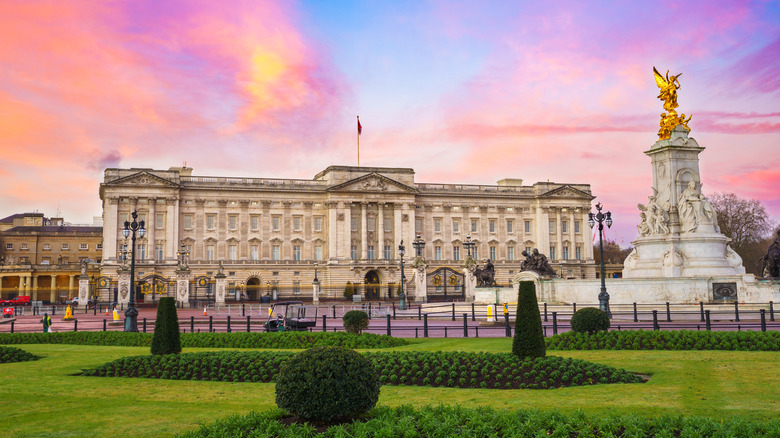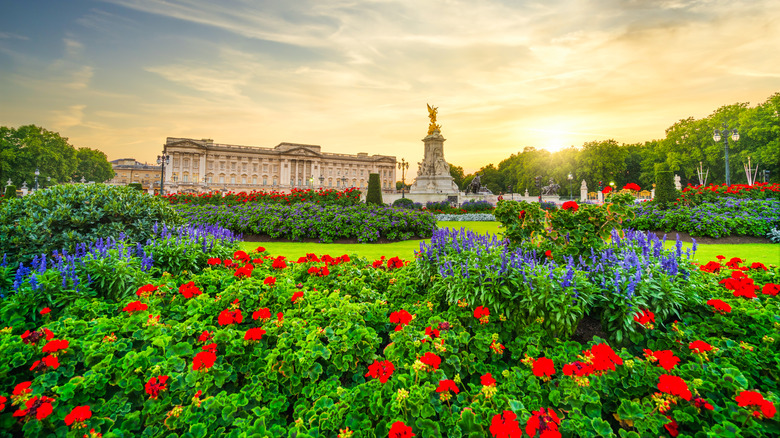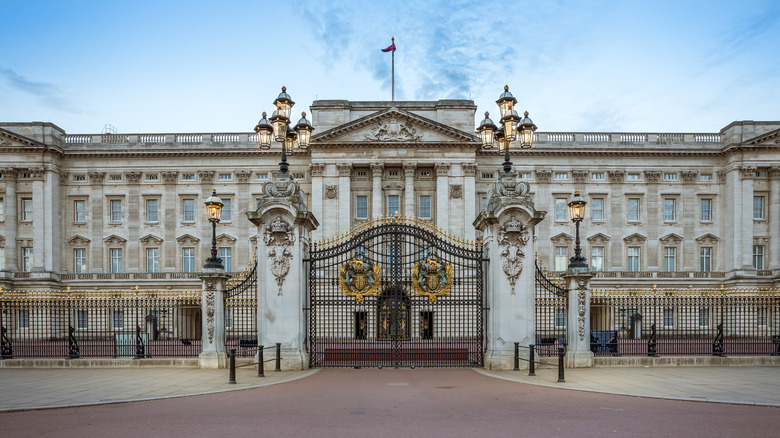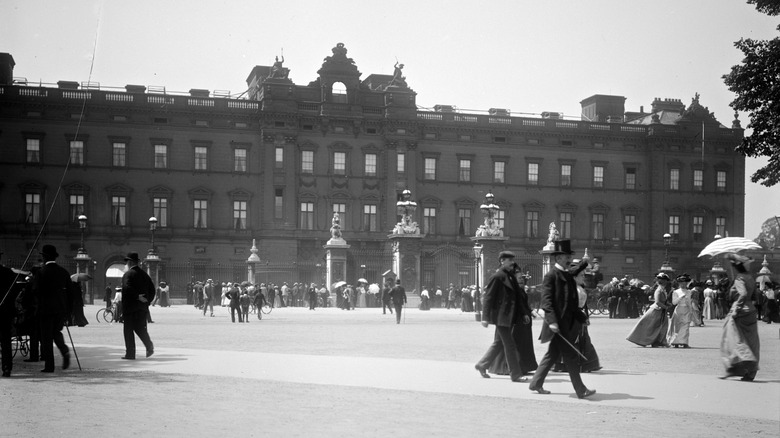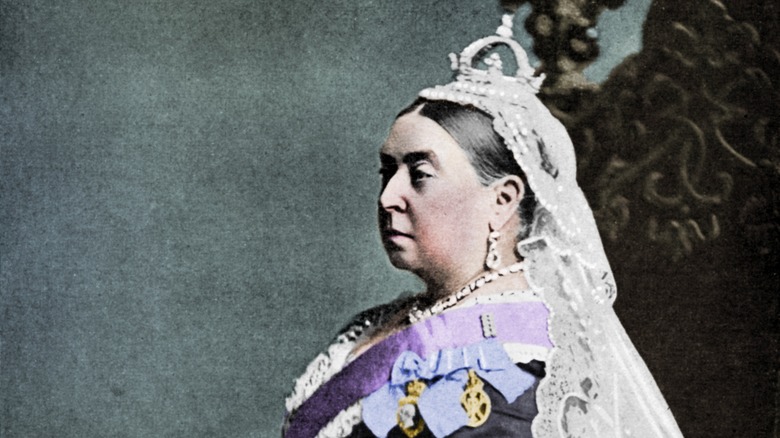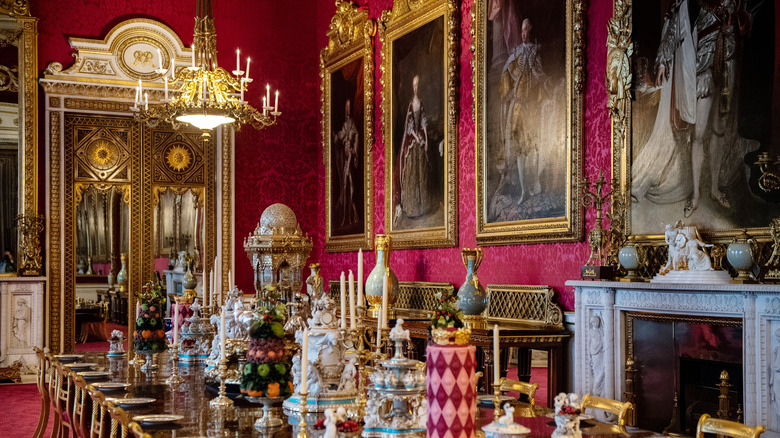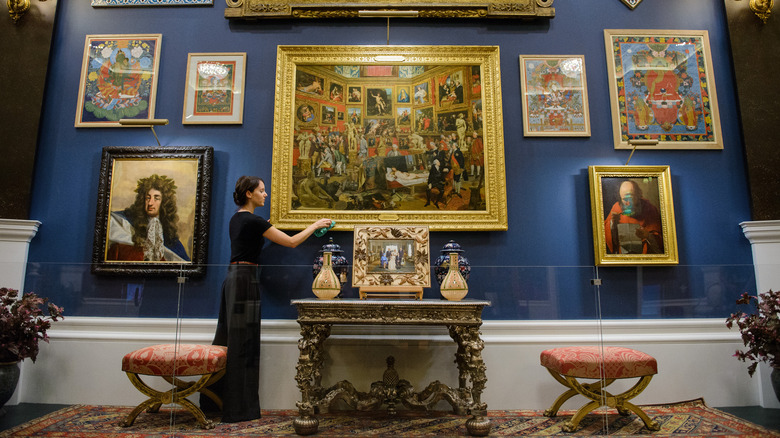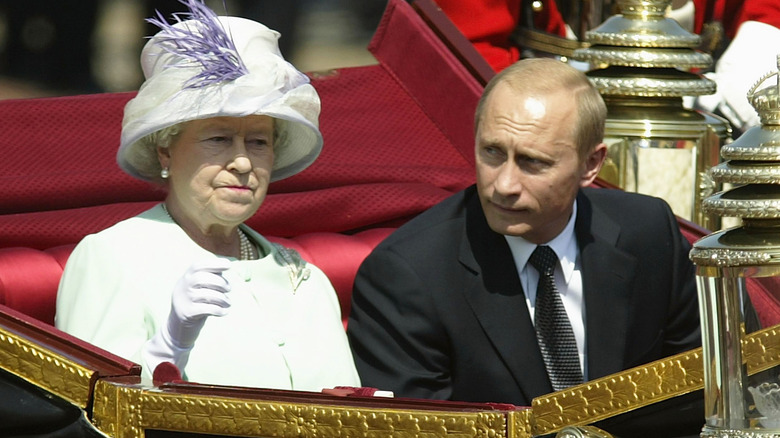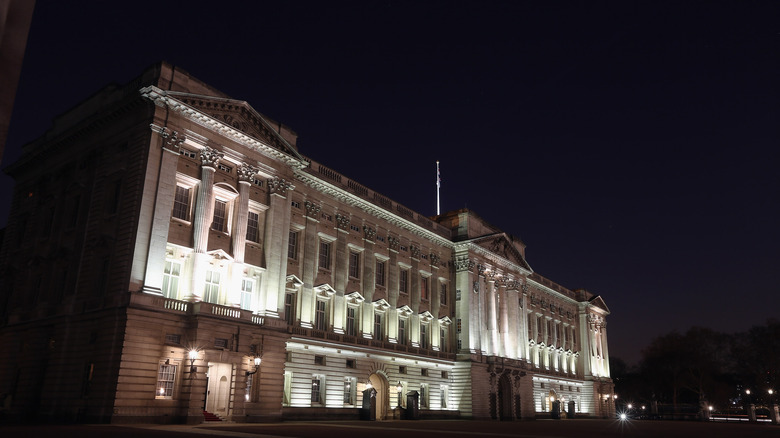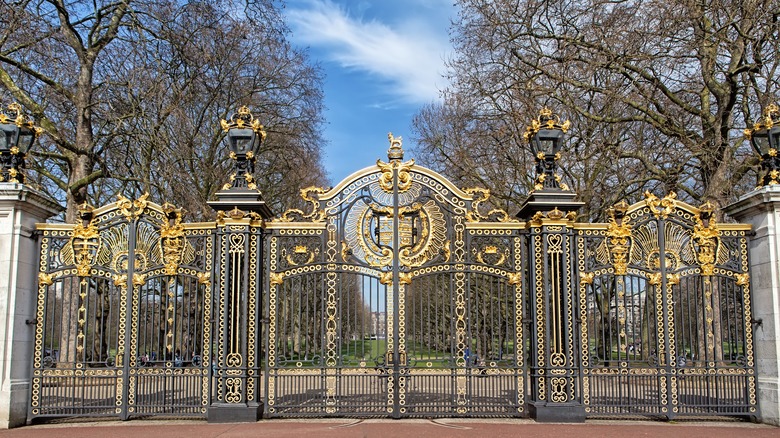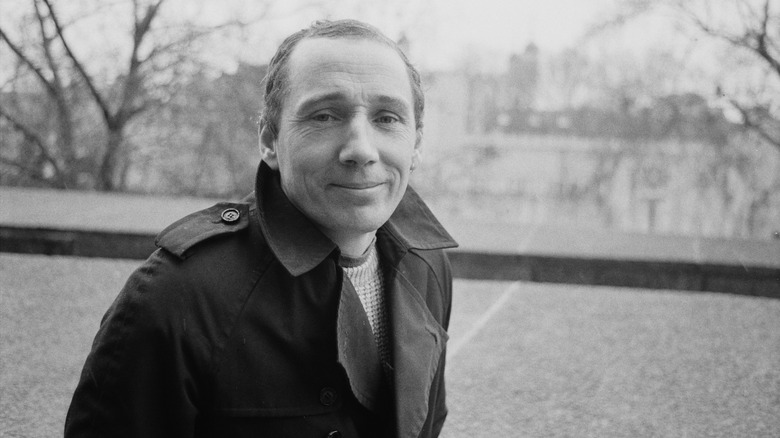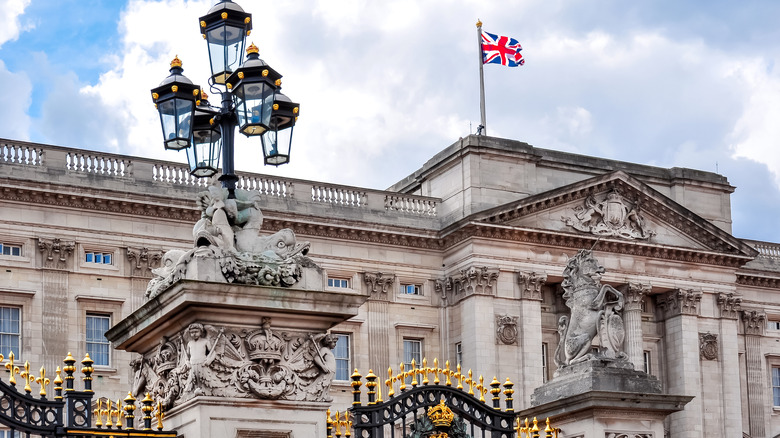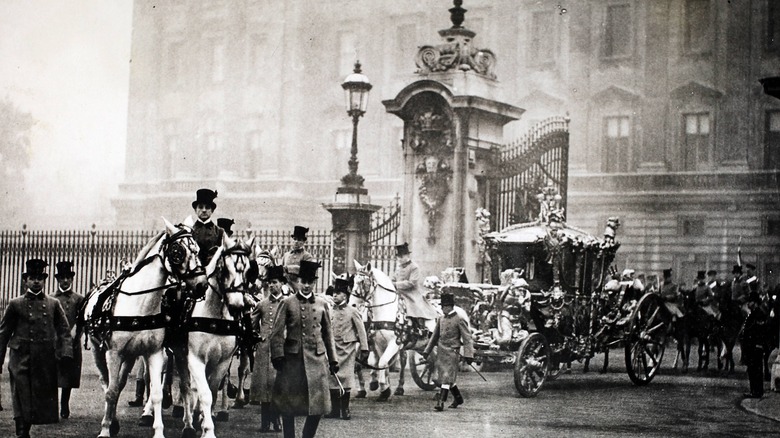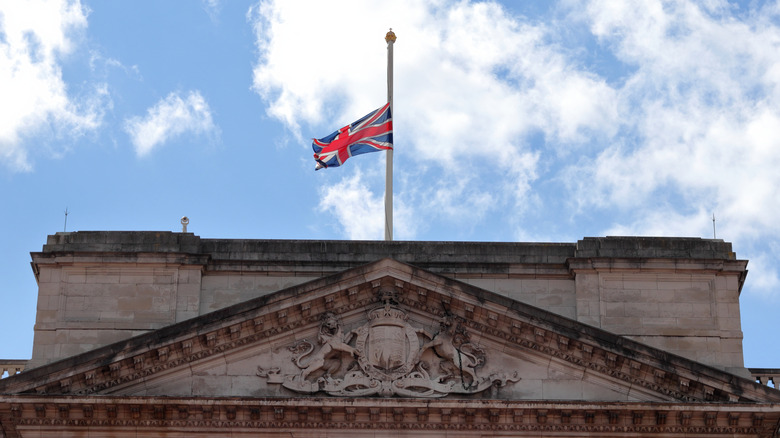The Untold Truth Of Buckingham Palace
What do you get if you cross a buck, a king, and a ham? A palace! And not just any palace but one renowned worldwide as a historical landmark where the British royal family has resided for centuries. Sitting in the heart of London, the official residence of Queen Elizabeth II has survived two World Wars, social upheaval, abdications, scandals, and even a break-in or two. Yet, much like the monarchy or a relic from a bygone age, it remains standing. Today, Buckingham Palace is a tourist hotspot. Crowds flock from all corners of the globe to have their picture taken outside the royal residence. The great and good go there to be knighted, dignitaries and politicians take tea there, and Brian May from Queen occasionally plays guitar solos on its sprawling roof, as per Metro.
If you've ever visited Buckingham Palace and wandered in a sublime stupor amongst its fine art, admired the majesty and might of its Throne Room, and laughed at the comical appearance of the Queen's guards in their bearskin hats, you'll appreciate that Buckingham Palace remains out of step and out of time with the modern world. It's an institution, a landmark, and a house fit for a king or queen. Let's bypass the official tour, dodge the Beefeaters, and make our way into the hidden corners of the palace to blow away the cobwebs and shine a light on its untold truth. Begging Her Majesty's pardon, of course.
The site of Buckingham Palace was a former mulberry plantation
It's easy to look at the world's most iconic and famous architecture and assume it's always been there. Yet the Statue of Liberty hasn't always held her torch aloft, the Egyptian pyramids haven't always kept their mysterious vigil, and Stonehenge hasn't always baffled generations of curious minds. Time changes everything, and, just like people, behind every building, there is a backstory. In the case of Buckingham Palace, when James I sat on the throne, it was a mulberry plantation (via The Royal Collection Trust). The only son of Mary, Queen of Scots, was a keen silkworm farmer and grew a mulberry plantation on the site of Buckingham Palace. According to Everything Silkworms, silkworms get everything they need from mulberry leaves, including their necessary liquid intake.
The plantation sat directly where you can now find the Palace Garden. According to Londontopia, some mulberry trees were planted there in 2001 in honor of the failed endeavor by James I. During the reign of Charles I, the land where the plantation was located was gifted to Lord Aston. Records from 1628 indicate that there was already a large house on the site during this period. After changing hands many times, it fell into the care of John Sheffield in 1698, also known as the Duke of Buckingham. Believing the house to be too quaint and old-fashioned, the Duke demolished the property and commissioned a new dwelling named Buckingham House.
George III purchased Buckingham House in 1762
Former soldier John Fitch built Buckingham House for a little over $8,000. Fitch had no idea he was responsible for history in the making, but when George III purchased the house and lands in 1762, a ball was set in motion, as per The Royal Collection Trust. Although the official royal residence remained at St James' Palace, George III maintained Buckingham House as a private pad where his wife, Queen Charlotte, could enjoy a spot of privacy. Between moving in and 1776, he launched an extensive and ambitious modernization project to help Buckingham House inch further along the road to becoming a palace (via Londontopia). Robert Adam designed the ceilings, Giovanni Battista painted them, and Sir William Chambers was in charge of the remodeling.
King George III was also something of a bookworm and built an extensive library at Buckingham House (via British Heritage Travel). He gifted Buckingham House to his wife in 1775, and it was universally acknowledged as the Queen's House. George and Charlotte had 15 children, and 14 were born at Buckingham House. From 1791, Buckingham House was often described as Buckingham Palace. Yet because he struggled with Porphyria and suffered from serious bouts of illness, King George III lived out his final years at Windsor Castle. Upon his father's death in 1820, a 60-year-old George IV ascended to the throne with big ideas about how to turn the house he grew up in into a palace.
The redesign of Buckingham House into a Palace went way over budget
George IV had a vision to transform Buckingham House into a palace that would serve as a seat of court for the British royal family for generations to come. Yet it was a vision that came with an extremely high price tag. Londontopia reports that in May 1825, the Chancellor of the Exchequer asked famed architect John Nash to submit a proposal for the redesign and extension of Buckingham House. Nash, who was also responsible for designing Regent Street, Piccadilly Circus, and refurbishment work at St James's Palace, gave Buckingham Palace its iconic look. The Royal Collection Trust reports that by extending the house into a U-shaped building that enclosed a stately forecourt, Nash gave Buckingham House a distinctive and imposing look better suited to a palace.
However, although acclaimed as an architectural masterpiece, Nash went way over budget. His extravagance was deemed too high a cost for the taxpayer to continue paying. Shortly after George IV passed away in 1830, the Prime Minister politely informed Nash his services were no longer required. William IV, who succeeded George IV, had little interest in relocating from his digs at Clarence House to the still unfinished Buckingham Palace. Yet a sovereign who would gladly call it home was waiting in the wings.
Queen Victoria was the first sovereign to reside at Buckingham Palace
Buckingham Palace could have had a very different use. During his reign, William IV's offered it as a replacement for the old House of Parliament, which had been ravaged by a fire. Yet the government was determined to complete and perfect the palace for royal use, as per The Royal Collection Trust. In the wake of William IV's death in 1837, Queen Victoria moved in. Yet, since the palace hadn't been inhabited since George IV's renovations, the new queen found the conditions a bit dire (via Londontopia). In 1845 she voiced her grievances to Prime Minister Robert Peel, stating there wasn't enough space for her accommodation and entertainment needs. So architect Edward Blore was called upon to step into John Nash's old shoes and finish the job.
The sale of the Brighton Pavilion was used to finance the works, the most significant of which was the main facade's central balcony. The balcony, which was Prince Albert's suggestion, has become a focal point of royal and national occasions. From the royal balcony, Queen Victoria said farewell to British troops as they set off to the Crimean War, and bid them a welcome home upon their return. The Royal Collection Trust reports that for 20 years, Queen Victoria and Prince Albert transformed the old house into a vibrant and dynamic court. Yet after Prince Albert died in 1861, an air of mourning fell over the palace, which did not lift until 1901, when her long reign came to an end.
Buckingham Palace has a mind-blowing 775 rooms
According to The Royal Household, over 50,000 people are invited to Buckingham Palace each year to attend garden parties, official dinners, state banquets, various receptions, and, if you're the Prime Minister, a weekly audience with Queen Elizabeth II. With all that entertaining, you're going to need plenty of space. It's a good thing the palace contains a mind-blowing 775 rooms, with 52 rooms for royals and their guests. A further 188 bedrooms are allocated for staff, 92 for offices, and 19 are designated staterooms. And if you ever feel like freshening up after a day spent pressing palms and nodding sagely, then you're in the right place. Buckingham Palace is big on sanitation, with a whopping 78 bathrooms.
Buckingham Palace still houses George III's immense library; other notable rooms include the White Drawing Room and the Ballroom. It's the Ballroom where British citizens receive their honors, and it has played host to everyone from Tom Hanks to Barack Obama. The Queen's beloved dogs once had their very own room, named the Corgi's room. There's also the Queen's Breakfast Room — which is more like a canteen hall — as well as the Crimson Drawing Room, the Picture Gallery, the White Drawing Room where the royals assemble before an official event, and the center room which leads directly to the royal balcony. There is also the Throne Room, which is often used for formal pictures.
Buckingham Palace houses an extremely exclusive art collection
A palace wouldn't be a palace without an original Rembrandt hanging on the walls to remind guests of the owner's wealth, status, and exquisite taste. The British royal family has rather an extensive art collection to pick from when decorating the walls of Buckingham Palace. The Art Newspaper reports that the Royal Collection is worth an estimated $12 billion and consists of about 7,000 paintings and 500,000 prints. And that's before you factor in the 30,000 watercolors and drawings, the photography, sculptures, ceramics, manuscripts, and Crown Jewels. It's an awful lot of culture to wade through, but one of Queen Elizabeth II's faves is Rembrandt's "The Shipbuilder and his Wife" from 1633.
The Royal Collection is one of the world's biggest and most important treasure troves of art (via The Royal Collection Trust). Yet amongst the Old Masters such as Titian, Van Dyck, and Vermeer, you'll still find works by more modern artists such as Andy Warhol and Anish. It would appear the royal family has quite varied tastes. The newly expanded Queen's Gallery, which houses an ever-evolving supply of art from the Royal Collection and is available for public viewing, was opened in 2002 as part of the Queen's Golden Jubilee celebrations. It cost over $20 million, was funded by the Royal Collection Trust, and was the most significant building work to take place in Buckingham Palace for over a century (via The Royal Collection Trust).
Buckingham Palace has had its fair share of controversial guests
Buckingham Palace has wined and dined a lot of guests over the years, and not all of them have been the most wholesome characters. Sky News reports that Donald Trump triggered protests when a state banquet was held in his honor in 2019. In 2015 Chinese President Xi Jinping was given the nod to attend the palace to widespread criticism from human rights protestors. During a 2007 visit by Saudi Arabia's King Abdullah, angry activists lined The Mall and shouted "shame on you."
In 2003 U.S. President George W. Bush was also in the firing line as his visit to Buckingham Palace was overshadowed by protests against the Iraq war. In 1998, it was the turn of Japan's Emperor Akihito. After failing to publicly apologize to former British prisoners of the Second World War, they responded by making the symbolic protest of turning their backs in his presence. Vladimir Putin was the first Russian head of state since Tsar Nicholas to visit the U.K. and the first to visit Buckingham Palace. Yet by far, the most controversial guest was Zimbabwe's Robert Mugabe, who attended Buckingham Palace in 1994 for a four-day visit and to receive a knighthood. It was revoked in 2008, when it became public knowledge he was murdering his opponents.
Buckingham Palace is said to be haunted
When a building is as old, as big, and has housed as much history as Buckingham Palace, chances are there will be at least a few ghosts rattling around the place to keep every new set of occupants on their toes. Nearly every building from Victorian times or earlier has a haunted quality that suggests it's home to all manner of otherworldly occurrences, and Buckingham Palace is no different. A few spirits are said to stalk its interior, rattling their chains and moaning unnervingly about life in the afterworld, but the oldest is said to be a monk whose haunting ground is the rear terrace. MyLondon reports that the site was once a monastery, and the monk is believed to have died in the monastery's punishment cell. It's rumored he prowls the area despondently for eternity in a brown cowl and chains.
Major John Gwynne was the private secretary to King Edward VIII, and according to The Daily Express, his ghost is rumored to haunt Buckingham Palace still. After Gwynne divorced his wife due to scandal, he was shunned from the upper echelons of polite society. With the shame becoming too much to bear, he retired to his first-floor office within the palace and died by suicide. It is rumored that staff has often allegedly complained about a negative and unsettling vibe emanating from its interior.
If you or anyone you know is having suicidal thoughts, please call the National Suicide Prevention Lifeline at 1-800-273-TALK (8255).
A teenager broke into Buckingham Palace in Victorian times to steal a very unusual item
You would think that the palace where the British royal family lived would be a veritable Fort Knox for keeping out have-a-go burglars, but you'd be wrong! The BBC reports that in Victorian times a teenager broke into the royal realm to steal — not the Crown Jewels or the serving silver — but a pair of Queen Victoria's panties. Edward Jones, also known as Boy Jones, was a 14-year-old with an obsession with Queen Victoria, leading him to be called the first celebrity stalker. Cardiff University's Dr. Jan Bondeson explained, "Edward Jones was a very weird character and apart from Queen Victoria, he was never interested in women. He was a very solitary character but he was not schizophrenic or classed as mad, just odd."
In an age before Buckingham Palace had any security, Jones broke in a total of four times through unlocked doors or open windows. Dr. Bondeson revealed the first time Jones was caught he had the monarch's panties, and on other occasions, he was seen lounging on the throne and stealing food from the kitchen. Because of his perpetual stalking, the government decided to put him on a prison ship for six years. Boy Jones eventually settled in Perth, Australia, where he earned renown as the town crier. Dr. Bondeson added, "He was very annoyed about always being known for being the queen's stalker and felt persecuted by the jokes, even in Australia."
A man once broke into Buckingham Palace for a chat with the Queen
Getting an audience with Her Majesty is impossible for the majority of the common folk, but in 1982, British man Michael Fagan took matters into his own hands and broke into Buckingham Palace for a chat with Queen Elizabeth II, as per Smooth Radio. During his first attempt at entry, he was spotted scaling a drainpipe by a housemaid. She informed the guards, but when they arrived on the scene, Fagan had already gained entry through an open roof window. Once inside, he had a whale of a time eating cheese, drinking wine, and admiring royal portraits. He tripped two alarms, but the police dismissed it as a routine fault.
The second time Fagan broke in, he made his way to the Queen's bedroom. It was claimed Fagan sat on the end of the Queen's bed and conversed pleasantly with her. However, he told The Sun in 2020, "I pulled back the curtains, and the woman in bed sits up and says in an accent like the finest glass, 'What are you doing here?'" Fagan admits he remained dumbstruck as the Queen said, "Just one minute, I'll get someone," and left the room in her nightdress. Fagan was never charged with trespassing and had no regrets. He told The Sun, "People who have done marvelous things get to kneel in front of her to be honored but I actually sat on her bed and almost got to talk with her."
Buckingham Palace is home to some pretty unusual things
The Queen and her nearest and dearest don't just rattle around Buckingham Palace all on their lonesome. No sir! It takes a lot of cogs to make the royal wheel go around, and the Queen's London digs are home to over 188 staff bedrooms and 800 members of staff, as per MyLondon. Living in a palace must be a surreal experience, but the monarchy has done its best to make it a home away from home for its staff. In addition to a staff cinema that has regular screenings, workers can send postcards and e-bay packages courtesy of the Court Post Office.
As we all know, life can become quickly unbearable without a heated indoor swimming pool where you can recline on a giant inflatable unicorn, sip Pina Coladas, and read Satre. It's a good job Buckingham Palace has a pool for both staff and royal use. Prince George learned to swim in it. There's also the Royal Mews Surgery, for staff who feel a bit under the weather. Yet if staff wish to draw some money out for a big night out, they'll have to do it elsewhere. Deep in the bowels of Buckingham Palace, there is an ATM, but it is strictly reserved for royal use. Although, if a staff member is a bit strapped for cash, we're sure the Queen would lend them a fiver.
There is a secret passage in Buckingham Palace
Who here doesn't like a good story about a James Bond-style secret passage? There is something timelessly mysterious and alluring about a concealed entrance, created by unknown hands and leading to god knows where. Such hidden passages are symbolic of mystery, adventure, and the unknown. And guess what — the Queen has one in Buckingham Palace. Yahoo! reports that concealed behind a floor-to-ceiling mirror and dresser in the White Drawing Room is an entrance to a secret tunnel that leads to the Queen's private chambers. The secret passage finally came to light when Royal Collection Trust curator Anna Reynolds revealed it in a guided tour video.
Reynolds explained, "This is the way to the Queen's apartments, and often when the Queen is meeting guests, they're lined up here in the music room for her to meet. It allows her to make an entrance without having to walk through all the Palace rooms." If that wasn't enough to confirm the Queen's 007 credentials, Marie Claire reports that at Windsor Castle, she also has a secret escape hatch buried beneath some plush carpet in the corner of an office. The historic trap door leads to a passage that spills out onto a nearby street. It was intended to be used by soldiers when things got a little heated during enemy sieges. BBC presenter Fiona Bruce explained that the royal passage was designed to "accommodate a whole army of men."
Buckingham Palace was bombed during the war
During the Second World War, when the Luftwaffe was busy raining down a shower of death and destruction on England's capital, Buckingham Palace did not escape unscathed. According to British Heritage Travel, London was already reeling from the Blitz when the Nazis decided to up the ante and bomb the palace. On September 8th, 1940, a 50-kilogram bomb fell inside the palace's grounds. Miraculously it didn't explode and was safely deactivated. Yet five days later, on the morning of Friday 13th — a day that everyone associates with dark omens at the best of times — Buckingham Palace came close to going up in smoke.
The Queen Mother recalls drinking tea with her husband, George VI, when the "unmistakable whirr-whirr of a German plane" and the "scream of a bomb" caught their attention. Herman Goering's Luftwaffe had scored five direct hits on the palace and caused damage to the inner quadrangle, the Royal Chapel, the Victoria Memorial, and the palace gates. Three palace staff members sustained injuries, and one was killed. The bombing shook the entire royal family. The government advised them to leave Buckingham Palace and the country. However, the Queen Mother issued a statement, explaining, "The children will not leave unless I do. I shall not leave unless their father does, and the King will not leave the country in any circumstances, whatever." Buckingham Palace escaped the rest of the war unscathed and continues to stand the test of time.
